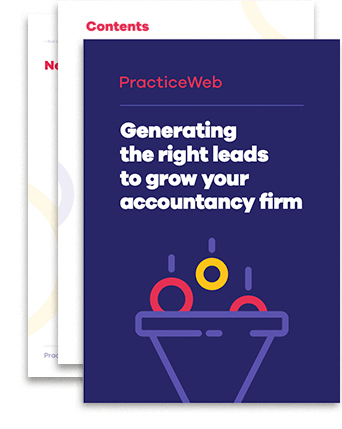Lead generation for accountants
How to generate the right leads to grow your accountancy firm
Before you can put a plan together for the year, you need to first understand where to focus your marketing and business development efforts.
Take a step back before you start looking at your tactical marketing plan and address what is a valuable lead to your firm? How will you obtain and qualify these leads and move them through the buying cycle?
In this complete guide we will look in detail at who you are trying to attract and why, methods for engaging them, and the importance of collecting and maintaining this information.
The following areas are covered:
- Who are you trying to attract?
- What are you trying to achieve?
- How do you differentiate your firm in the market?
- The difference between leads and prospects
- Lead generation process
- Lead generation tactics
- Tools for measuring lead generation
- Putting it all into practice.
Download the eBook
Sample: The complete guide to lead generation for accountants
This guide was created by the PracticeWeb team with input from Zoe Sweet, Mike Crook, Alex Tucker, Ray Newman and Philippa Jordan.
Introduction
Where will you get your new business, what activities should you undertake and how will you measure success for your firm?
Growing their accountancy practices is one of the main aims for ambitious accountants.
The marketing strategy your firm puts together needs to set out where you’ll get new business, what you need to do to generate interest and, most importantly, how you’ll go about recording and measuring information to track return on investment.
With more choice than ever, and less incentive to be loyal to their accountant, today’s business clients are more savvy and firmly in control. The experience they have with one company compared with another has significant bearing on their purchasing decisions.
To create the experience the consumer demands and unlock the potential this can bring, it’s vital to know exactly who you are targeting, what motivates them and how they make buying decisions.
If you don’t have a clear picture of what your ideal clients look like, or this isn’t clearly communicated to your team, you risk attracting those you frankly don’t want. As a result, you’ll struggle to scale up, or could end up going in the wrong direction.
It’s not uncommon for successful businesses to lose focus as they attempt to grab every sales opportunity that comes their way.
Once you have identified your target client, it’s essential to adopt a lead generation strategy to attract and gain new business.
The most important part to this is correctly labelling, tracking and reviewing where your customers are throughout the buying process. Customer relationship management (CRM) systems are a great way to record this but remember, they are only as good as the information you put into them and must be kept up to date.
At PracticeWeb, we’ve spent time refining our idea of who our target clients are and shaping our proposition around their needs. Because we know this approach works – we’ve tested it on ourselves – this is now the process we follow to take clients through in our strategy development process.
In this guide we will look in detail at who you are trying to attract and why, methods for engaging them, and the importance of collecting and maintaining this information.
Before you can put a plan together for the year, though, you need to first understand where to focus your marketing and business development efforts.
Take a step back before you start looking at your tactical marketing plan and address what is a valuable lead to your firm? How will you obtain and qualify these leads and move them through the buying cycle?
Who are you trying to motivate?
It’s important to build an emotional connection with your clients, and you can’t do that if you don’t have a clear picture of who they are.
Don’t worry about the details at first – just get a broad idea of who is most likely to buy your services.
This is a great opportunity to test internal knowledge of your target clients by bringing together a cross section of people from across the business for an open discussion, from which you should see some distinct target groups emerging.
Next, agree some hard facts that apply to those emerging target clients:
• What are their job titles?
• How many people do they employ?
• What frustrates, worries or blocks them?
• Think about their motivations, and what you believe influences them in their decision-making.
At the end of this process you should have a set of buyer persona profiles. Make them visible across the organisation so your teams can start to focus on those target clients in their work.
PracticeWeb specialises in taking our client through this process so please get in touch to see how we can help you identify and create buyer personas with your customers in mind.
What are you trying to achieve?
Now you know who you’re targeting, the next step is to set your goals.
First, agree on the long-term goal: what does the business want to achieve in the next year or two? This will maintain focus, define your course, support critical decision-making and help resolve conflicts.
Aim: understand where you are now, where you want to be, and how marketing can help you get there.
Agree business goals, for example:
- Generate £X amount of new revenue by year-end.
- Launch a new service by X date.
- Reposition business by X date.
- Target new customer segments.
- Expand into a new sector.
Agree marketing goals, for example:
- Building awareness
- Educating buyers
- Nurturing leads
- Engaging with influencers
- Serving existing customers
- Cross-selling or upselling
- Generating new sales leads
- Establishing your expertise.
How do you differentiate your firm?
Defining and marketing what sets you apart means more than coming up with a strapline. You need to discover, define and articulate a value-driven proposition that resonates with your clients and that your whole business can believe in.
You should have a good idea of what your target buyer personas value. Combine this understanding with what your business is deeply passionate about, what you believe it can be the best at, and what fuels your economic engine. (That is, what really makes money for your firm.) All of this should inevitably point to a differentiator that reflects your business and its customers.
Aim: create a customer centric value proposition that resonates with, and attracts, your target clients.
We use something called the Hedgehog Concept. Created by the business consultant Jim Collins, this framework enables you to:
- understand what you and the business are truly passionate about
- identify what the organisation does better than anyone else, and
- determine where it’s good at generating revenue
Once you have this and your buyer persona information you need to come up with a proposition, which is by far the hardest part. It’s all about creative thinking – matching what your clients value, what you’re passionate about, what you can do better than anyone else and your revenue driver.
Your value proposition will form the core of your competitive advantage, clearly articulating why someone would want to buy from your company instead of a competitor.
Our digital marketing strategy workshop is designed to help shape your proposition around your target clients.
Once you have a clear idea who you are going after and how many new clients you need it is important to record and track your progress so that you can evaluate and adapt your methodology once you discover what works for your business.
We would strongly encourage all accountancy practices to invest in a customer relationship management (CRM) system.
The importance of a centralised system is that it will become your single point of truth, holding key data such as buying information, contact details, brand interactions. It makes it possible to review habits and trends in a meaningful way.
To gain the maximum return from your CRM system you should integrate it with other assets such as your website submissions, email marketing tools, live chat, social media, telephone and messaging services.
Leads and prospects
Agree on a standard labelling format with your teams.
Businesses often use different terminology to mean essentially the same thing – for example, ‘leads’, ‘prospects’ and ‘opportunities’ all refer to potential clients.
As a result, it’s easy to get confused by the sales jargon, which can have a knock-on effect when it comes to tracking this information.
The most important thing is to ensure that within your business you have a clear understanding and agreement as to what standard labeling will be used, and what it means to you and your colleagues. You need a common language.
Here’s a quick guide to the most common terminology below.
What is a lead?
Someone who comes directly to you.
A lead is a potential customer or client who has reached out to your business either directly via email, web submission or inbound call, responding to some form of advertising or engaging content.
At this stage you will have some identifying information such as a name, email address and possibly a phone number or company name.
As yet, you have not ‘qualified’ this lead so you don’t know if they are the right fit to become a potential client.
It is important to acknowledge all leads and make contact so you can qualify them. To make qualification easier, you should think about those buyer personas. This will help the sales teams avoid wastingmtime and energy pursuing bad matches.
It’s fine to identify leads as lost and close them at this stage if they don’t fit.
What is a prospect?
A lead qualified as being fit for your services and progressing towards a decision.
Once qualified, a lead becomes a prospect. This is where the excitement begins and often a lot of legwork.
By now, they should be identified as fitting your target market, having the means to do business with you and be the authorised decision maker.
Confirming all this early on will save you a lot of valuable time and energy.
At this stage, you have identified that the prospect has a problem or issue that your product or service can solve.
In a business-to-business environment this one prospect can turn into many people who need convincing – partners, investors and other stakeholders.
This is only possible through understanding their implicit needs and adopting a……..
Download your copy to read further sections on:
- What is lead generation?
- The lead generation process
- Where do leads come from?
- How many leads do you need?
- How do you calculate lead generation?
- Lead generation tactics
- Pay-per-click (PPC
- Retargeting
- Search engine optimisation (SEO)
- Social media
- Content marketing and blogging
- Guest blogging
- Referral marketing
- Affiliate marketing
- Buying leads
- Tools for measuring lead generation
- Google Analytics
- Customer relationship management (CRM)
- Social media monitoring
- Google Data Studio
- Putting it all into practice.




